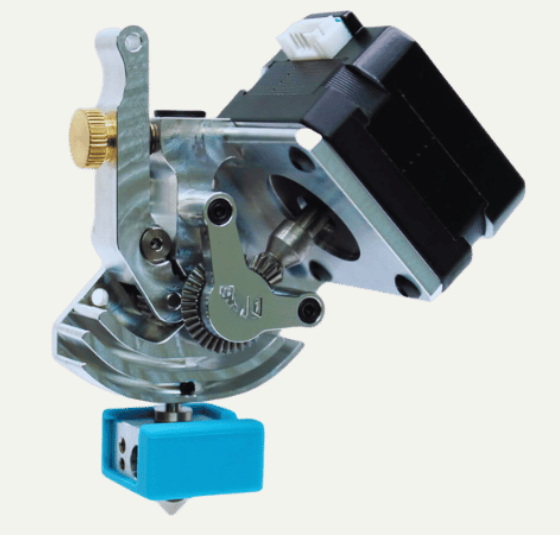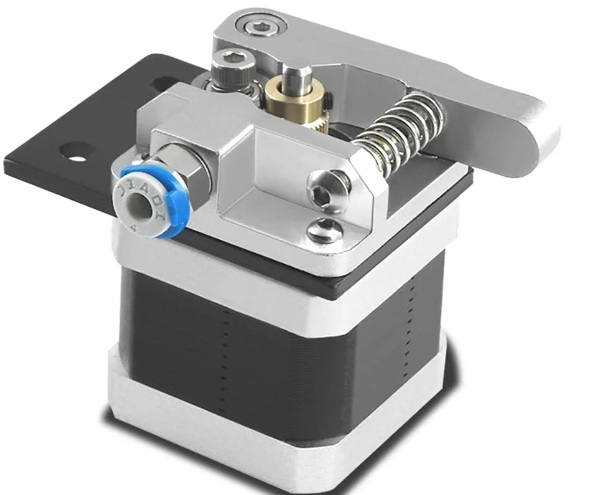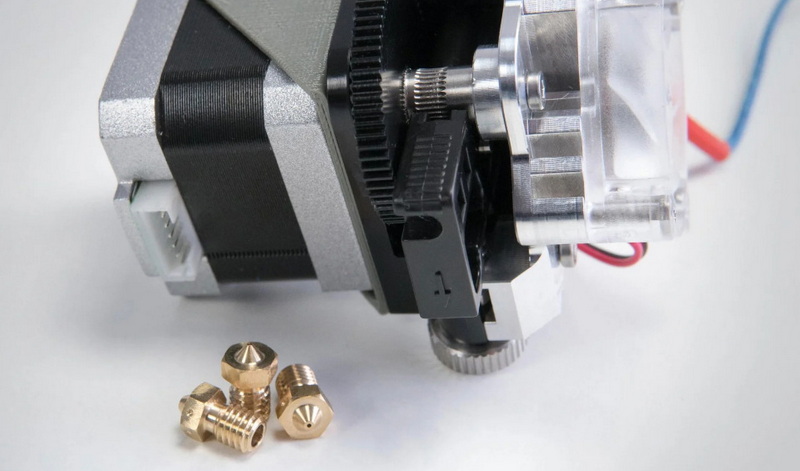Content Menu
● Understanding 3D Printing Extruders
● Advantages of Bowden Extruders for High-Speed Printing
● Why Aluminum? Material Matters
● Technical Considerations for High-Speed Printing with Aluminum Bowden Extruders
● Practical Applications of Aluminum Bowden Extruders in High-Speed 3D Printing
● Case Studies: Real-World Examples
● Challenges and Limitations
● The Future of Aluminum Bowden Extruders in 3D Printing
● Conclusion
● FAQ
>> 1. What are the main advantages of using an aluminum Bowden extruder for high-speed 3D printing?
>> 2. How do I optimize retraction settings for an aluminum Bowden extruder?
>> 3. Are aluminum Bowden extruders suitable for flexible filaments?
>> 4. How often should I maintain my Bowden tube, and what does maintenance involve?
>> 5. What role do firmware and software settings play in achieving high-speed prints with an aluminum Bowden extruder?
● Citations:
3D printing has revolutionized manufacturing, prototyping, and even personalized creation. As the technology evolves, the demand for faster, more efficient printing solutions grows. One key component in achieving high-speed 3D printing is the extruder, and among the various types available, the "aluminum Bowden extruder" stands out as an ideal choice for many applications. This article delves into the reasons why an "aluminum Bowden extruder" is particularly well-suited for high-speed 3D printing, exploring its advantages, technical considerations, and practical applications.

Understanding 3D Printing Extruders
Before diving into the specifics of "aluminum Bowden extruders", it's essential to understand the fundamental role of an extruder in 3D printing. The extruder is responsible for feeding filament—the raw material of 3D printing—to the hot end, where it is melted and deposited layer by layer to create the final object. There are primarily two types of extruders: direct drive and Bowden.
- Direct Drive Extruders: In a direct drive system, the extruder motor is mounted directly on the print head, close to the hot end. This configuration provides precise control over filament feeding and retraction, making it suitable for flexible filaments and intricate designs[3].
- Bowden Extruders: In contrast, a Bowden extruder has the motor mounted away from the print head, typically on the printer's frame. The filament is fed to the hot end through a long PTFE (polytetrafluoroethylene) tube, also known as a Bowden tube[1].
Advantages of Bowden Extruders for High-Speed Printing
Bowden extruders offer several advantages that make them ideal for high-speed 3D printing.
1. Reduced Print Head Weight:
One of the most significant advantages of a Bowden extruder is the reduced weight on the moving print head[1]. By mounting the motor on the printer frame, the print head becomes lighter, allowing for faster and more agile movements. This reduction in weight minimizes vibrations and reduces the risk of print surface imperfections at high speeds[2].
2. Increased Printing Speed:
The lighter print head in a Bowden system allows for higher travel speeds, which directly translates to faster printing times[1]. The printer can quickly change direction and accelerate/decelerate without the inertia caused by a heavy direct drive motor. This is particularly beneficial for large prints where time savings can be substantial[1].
3. Enhanced Stability and Reliability:
With less mass on the print head, there is reduced stress and strain on the printer's mechanical components[1]. This enhances the durability and reliability of the printer, especially during long production cycles or when printing large-sized objects. The reduced weight also minimizes vibrations, leading to more consistent print quality[3].
4. Suitability for Large Prints:
Bowden extruders are particularly well-suited for printers with large build chambers. The lighter print head can move more freely across the print bed, making it easier to produce large, high-quality prints[1]. The configuration ensures that the printer can maintain high speeds without sacrificing precision or stability.
Why Aluminum? Material Matters
The choice of material for the extruder components is crucial for performance and durability. Aluminum offers several benefits over other materials, such as plastic, making it an excellent choice for high-speed 3D printing.
1. Durability and Longevity:
Aluminum is significantly more durable than plastic, capable of withstanding the wear and tear associated with high-speed printing[9]. An "aluminum Bowden extruder" can endure prolonged use without degradation, ensuring consistent performance over time.
2. Heat Dissipation:
Aluminum has excellent thermal conductivity, which helps dissipate heat generated by the extruder motor[9]. This is particularly important in high-speed printing, where the motor may run continuously for extended periods. Effective heat dissipation prevents overheating and ensures stable operation.
3. Precision and Stability:
Aluminum components offer greater dimensional stability compared to plastic parts[4]. This precision is crucial for maintaining consistent filament feeding and retraction, which are essential for high-quality prints. An "aluminum Bowden extruder" minimizes the risk of mechanical issues that can compromise print accuracy.
4. Reduced Friction:
High-quality "aluminum Bowden extruders" are designed with smooth internal surfaces to minimize friction during filament feeding[4]. This reduction in friction allows for more consistent and reliable extrusion, especially when using flexible or specialty filaments. The smooth surface also reduces the risk of filament clogging.
Technical Considerations for High-Speed Printing with Aluminum Bowden Extruders
To maximize the benefits of an "aluminum Bowden extruder" in high-speed 3D printing, several technical considerations must be taken into account.
1. Retraction Settings:
Retraction is the process of pulling the filament back to prevent oozing when the print head moves between different parts of the print. In a Bowden system, the longer filament path requires careful adjustment of retraction settings[1]. Longer retraction distances (typically 3-6 mm) and optimized retraction speeds are necessary to compensate for the elasticity of the filament within the Bowden tube.
2. Print Speed and Acceleration:
While Bowden extruders are capable of high print speeds, it's essential to fine-tune the speed and acceleration settings to avoid issues such as ringing or ghosting. These artifacts occur when the printer's frame vibrates due to rapid movements. Experimenting with different speed and acceleration values can help find the optimal balance between speed and print quality[10].
3. Filament Choice:
The type of filament used can significantly impact the performance of a Bowden extruder[3]. While Bowden systems are generally suitable for rigid filaments like PLA and ABS, flexible filaments may require additional adjustments. Using a high-quality PTFE tube with a tight inner diameter can help minimize buckling and improve the feeding of flexible filaments.
4. Bowden Tube Maintenance:
Regular maintenance of the Bowden tube is crucial for ensuring consistent performance[1]. Over time, the tube can degrade or become clogged with filament debris. Inspecting and cleaning the tube regularly can prevent extrusion issues and maintain print quality. Upgrading to a high-quality Capricorn tube can also improve performance and reduce friction[5].
5. Firmware and Software Settings:
The printer's firmware and slicing software play a critical role in achieving high-speed prints with a Bowden extruder[10]. Features like linear advance or pressure advance can help compensate for the lag in filament feeding caused by the Bowden tube. These settings adjust the extrusion rate based on the printer's speed and acceleration, resulting in more accurate and consistent prints.

Practical Applications of Aluminum Bowden Extruders in High-Speed 3D Printing
The advantages of "aluminum Bowden extruders" make them suitable for a wide range of practical applications in high-speed 3D printing.
1. Rapid Prototyping:
In industries where time is of the essence, such as product development, "aluminum Bowden extruders" enable rapid prototyping by significantly reducing printing times[2]. Designers and engineers can quickly iterate on designs, create prototypes, and test new concepts without being limited by slow printing speeds.
2. Manufacturing:
High-speed 3D printing with "aluminum Bowden extruders" is valuable in manufacturing settings where large quantities of parts need to be produced quickly[1]. This is particularly useful for creating custom tools, jigs, and fixtures, as well as for producing end-use parts in low to medium volumes.
3. Education and Research:
In educational institutions and research labs, "aluminum Bowden extruders" facilitate faster experimentation and learning[8]. Students and researchers can quickly produce models, test hypotheses, and explore new 3D printing techniques without spending excessive time waiting for prints to complete.
4. Hobbyist and DIY Projects:
For hobbyists and DIY enthusiasts, "aluminum Bowden extruders" make it possible to complete projects more quickly and efficiently[9]. Whether it's creating custom parts for robotics, building scale models, or designing unique household items, high-speed 3D printing can significantly enhance the creative process.
Case Studies: Real-World Examples
To illustrate the benefits of "aluminum Bowden extruders" in high-speed 3D printing, let's consider a few real-world case studies.
1. Automotive Industry:
An automotive manufacturer used "aluminum Bowden extruders" to rapidly prototype new car components[2]. By reducing printing times by up to 40% compared to direct drive systems, they were able to accelerate the design process and bring new products to market faster.
2. Aerospace Engineering:
An aerospace company utilized high-speed 3D printing with "aluminum Bowden extruders" to produce lightweight structural components for drones[1]. The ability to print quickly and accurately allowed them to optimize designs and create highly efficient aircraft.
3. Medical Device Manufacturing:
A medical device manufacturer employed "aluminum Bowden extruders" to create custom prosthetic limbs for patients[8]. The speed and precision of the printing process enabled them to deliver personalized solutions in a timely manner, improving patient outcomes and quality of life.
Challenges and Limitations
While "aluminum Bowden extruders" offer numerous advantages for high-speed 3D printing, they also have some limitations that need to be considered.
1. Filament Flexibility:
Bowden systems can be less effective with highly flexible filaments due to the increased friction and potential for buckling within the tube[3]. Direct drive extruders generally offer better control and reliability when printing flexible materials.
2. Retraction Tuning:
Achieving optimal retraction settings with a Bowden extruder can be challenging and may require extensive experimentation[1]. The longer filament path necessitates precise adjustments to avoid stringing and ensure clean prints.
3. Maintenance Requirements:
Bowden tubes require regular maintenance to prevent clogging and ensure smooth filament feeding[6]. Neglecting maintenance can lead to extrusion issues and reduced print quality.
4. Complexity:
Setting up and calibrating a Bowden system can be more complex than a direct drive system, particularly for beginners[12]. Understanding the various settings and parameters is essential for achieving optimal performance.
The Future of Aluminum Bowden Extruders in 3D Printing
As 3D printing technology continues to advance, "aluminum Bowden extruders" are likely to remain a popular choice for high-speed applications. Ongoing research and development efforts are focused on addressing the limitations of Bowden systems and further enhancing their performance.
1. Advanced Materials:
New materials with improved flexibility and reduced friction are being developed to enhance the compatibility of Bowden extruders with a wider range of filaments.
2. Improved Tube Technology:
Innovations in tube technology, such as low-friction coatings and optimized inner diameters, are aimed at minimizing filament buckling and improving feeding reliability.
3. Smart Extruders:
The integration of sensors and feedback mechanisms into "aluminum Bowden extruders" can enable real-time adjustments to extrusion parameters, resulting in more consistent and high-quality prints.
4. Hybrid Systems:
Combining the benefits of both Bowden and direct drive systems through hybrid extruder designs may offer the best of both worlds, providing high speed and versatility.
Conclusion
In conclusion, the "aluminum Bowden extruder" is an excellent choice for high-speed 3D printing due to its lightweight design, enhanced stability, and suitability for large prints. The durability and heat dissipation properties of aluminum further contribute to its appeal, ensuring consistent performance and longevity. While there are challenges associated with filament flexibility and retraction tuning, ongoing advancements in materials and technology are addressing these limitations. As 3D printing continues to evolve, "aluminum Bowden extruders" will undoubtedly remain a key component in achieving faster, more efficient, and high-quality prints across various industries and applications.

FAQ
1. What are the main advantages of using an aluminum Bowden extruder for high-speed 3D printing?
An "aluminum Bowden extruder" offers reduced print head weight, enabling faster printing speeds and enhanced stability. Aluminum's durability and heat dissipation properties also contribute to consistent performance.[1][9]
2. How do I optimize retraction settings for an aluminum Bowden extruder?
Optimal retraction settings typically involve longer retraction distances (3-6 mm) and carefully tuned retraction speeds to compensate for filament elasticity within the Bowden tube.[1]
3. Are aluminum Bowden extruders suitable for flexible filaments?
While "aluminum Bowden extruders" are generally better suited for rigid filaments, using a high-quality PTFE tube with a tight inner diameter can improve the feeding of flexible filaments. Direct drive extruders are often preferred for highly flexible materials.[3]
4. How often should I maintain my Bowden tube, and what does maintenance involve?
Regular maintenance is crucial to prevent clogging and ensure smooth filament feeding. Inspect and clean the tube regularly, and consider upgrading to a high-quality Capricorn tube for improved performance.[6]
5. What role do firmware and software settings play in achieving high-speed prints with an aluminum Bowden extruder?
Firmware features like linear advance or pressure advance compensate for lag in filament feeding, resulting in more accurate and consistent prints.[10]
Citations:
[1] https://jieyatwinscrew.com/blog/what-is-a-direct-extruder/
[2] https://www.3dnatives.com/en/bowden-direct-extruder-3d-printing-250820234/
[3] https://manufactur3dmag.com/bowden-extruder-or-a-direct-drive-extruder/
[4] https://biqu.equipment/products/3d-printer-parts-mk8-extruder-upgrade-aluminum-alloy-block-bowden-extruder-cr10-1-75mm-filament-extrusion-for-mk8-cr-10-ender-3
[5] https://www.youtube.com/watch?v=BrYDH4RWojY
[6] https://uk.anycubic.com/blogs/3d-printing-guides/3d-printer-extruder-a-simplified-guide-to-understanding-direct-and-bowden-extruder
[7] https://store.anycubic.com/blogs/3d-printing-guides/3d-printer-extruder
[8] https://forum.makewithtech.com/t/3d-printing-speed-bowden-vs-direct-extruder-ender-3-v2-vs-upgraded-ender-5/3369
[9] https://www.youtube.com/watch?v=UtemZqFJ5rY
[10] https://www.matterhackers.com/articles/extruders-101:-a-crash-course-on-an-essential-component-of-your-3d-printer
[11] https://www.noon.com/saudi-en/ender-3-v2-metal-extruder-aluminum-mk8-bowden-extruder-with-40-teeth-drive-gear-compatible-with-creality-ender-3-pro-ender-5-pro-ender-5-plus-cr-10-series-3d-printer/Z346331D007C2C4779865Z/p/
[12] https://3dprinting.stackexchange.com/questions/18619/why-do-nearly-all-cheap-3d-printers-have-a-bowden-extruder
[13] https://forums.reprap.org/read.php
[14] https://www.ankermake.com/eu-en/blogs/printing-guides/3d-printer-extruder-types
[15] https://3dprinting.stackexchange.com/questions/2621/what-are-the-advantages-and-disadvantages-of-an-all-metal-hot-end-compared-to-on
[16] https://all3dp.com/2/bowden-tube-all-you-need-to-know/
[17] https://filament2print.com/en/blog/bowden-direct-extrusion
[18] https://www.3djake.com/info/guide/high-speed-printing-your-options
[19] https://www.youtube.com/watch?v=-S8Pf58zP4k
[20] https://www.reddit.com/r/3Dprinting/comments/18xjk3g/why_so_many_bowden_printers/
[21] https://www.cnckitchen.com/blog/which-is-the-strongest-3d-printing-extruder
[22] https://forum.makewithtech.com/t/3d-printing-speed-bowden-vs-direct-extruder-ender-3-v2-vs-upgraded-ender-5/3369
[23] https://timeto3d.com/products/mk8-extruder-aluminum-alloy-block-bowden-extruder-frame-1-75mm-filament-right-hand
[24] https://www.youtube.com/watch?v=3L3nPJZo04E
[25] https://www.youtube.com/watch?v=HbeiKs7MgOc
[26] https://he.aliexpress.com/i/1005006053486170.html
[27] https://www.reddit.com/r/3Dprinting/comments/11mxhue/need_tips_for_choosing_extruder_for_high_speed/
[28] https://www.youtube.com/watch?v=RxCCPewGrKk
[29] https://jiga.io/3d-printing/3d-printer-extruder-hot-end-guide/
[30] https://www.walmart.ca/en/ip/Tachiuwa-Upgrade-Replaces-3D-Printer-Parts-Extruder-Aluminum-Block-Bowden-for/PRD2GCI2YWCARPS
[31] https://www.youtube.com/watch?v=KP6uxwt6pV4
[32] https://makenica.com/everything-to-know-about-3d-printing-extruders/
[33] https://www.cnckitchen.com/blog/how-to-set-extruder-tension
[34] https://www.reddit.com/r/3Dprinting/comments/o9ltk0/bowden_extruders_what_are_the_options/
[35] https://www.matterhackers.com/articles/extruders-101:-a-crash-course-on-an-essential-component-of-your-3d-printer
[36] http://www.store.creality3d.com/blogs/all/3d-printer-extruder-bowden-vs-direct-extruder
[37] https://3dprinting.stackexchange.com/questions/tagged/bowden
[38] https://all3dp.com/2/3d-printer-extruder-guide/
[39] https://www.bcn3d.com/3d-printer-extruders-a-basic-guide/
[40] https://filament2print.com/en/blog/types-3d-extruders-and-hotend
[41] https://www.youtube.com/watch?v=TPyTiZ6-_jM
[42] https://store.anycubic.com/blogs/3d-printing-guides/3d-printer-extruder
[43] https://jieyatwinscrew.com/blog/what-is-a-direct-extruder/
[44] https://facfox.com/docs/kb/3d-printer-extruder-the-ultimate-guide
[45] https://www.reddit.com/r/3Dprinting/comments/ecti1k/bowden_drive_for_speed/
[46] https://makenica.com/everything-to-know-about-3d-direct-extruder/






















